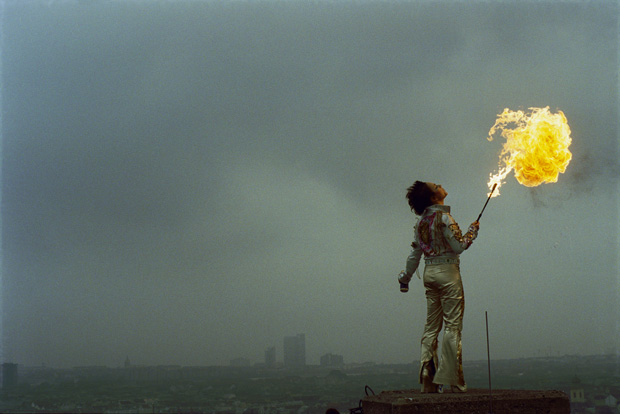by Owen Schaefer
Free association with the word Vienna would likely conjure up icons of its cultural and musical past, and Mozart is likely to come up before Sigmund Freud. So perhaps it is appropriate that the group show of Austrian artists currently showing at Tokyo Wonder Site’s Shibuya gallery is titled Psychoanalysis—it is as much a psychological examination of the viewer’s preconceptions of the country as it is a look into the way that Austrians, or at least Austrian artists, view themselves. And there is very little of the classical to be found.
Psychoanalysis is a show of film, photography and media arts that purports to look at the mind and body, and the unconscious emotional conflicts between them. And perhaps it comes closest to doing this with Markus Schinwald’s work. Originally interested in fashion, Schinwald turned away from the clothes and more toward the body and its gestures and movements. “Gestures mask intention,” says one line of the rhythmic voice-over for his film Ten in Love, in which ten people go through robotic motions in a room that looks more like the inside of a skull than anything else. They perform gestures of greeting and perhaps even love, but without any real connection. It’s absurd and pretentious, but since pretense is part of what’s being examined, it becomes strangely compelling.
Maria Hahnenkamp also focuses on the body, but takes a much more flexible approach. In the video from her Dress series, the midriff of a woman’s body in an ornately stitched red dress turns over and over, periodically pressing against what seems like the inside surface of the monitor or the glass of a photocopier. Looping around her, an academic text printed on a single long strip of paper advances as she moves. It is strongly evocative of a measuring tape, and the words quite literally measure her, and perhaps clothe her. And as you scan the image, you get the impression that she too is being scanned or photocopied, reproduced for the audience.
But oddly enough, the majority of works seem much more concerned with Austrian cities and architecture. Is it a metaphor for psychological structures we build for ourselves and how they might reflect in the places we choose to build? Perhaps, although no explanation is given. Aglaia Konrad’s mesmerizing film is a slow study of the concrete jumble of Fritz Wotruba’s Church of the Holy Trinity in Vienna-Mauer, and the film seems to take apart and reassemble the church by looking at it at all possible angles. Dorit Margreiter, too, approaches a single structure in her film Pavilion, though the structure here is more lived in, seemingly being used for dance rehearsals which we see only in passing, as the camera does its survey of the outside and inside walls.
And the group work of Bitter/Weber turns computer source code into photographic images of urban planning. In other works, the duo crop out prominently identifiable buildings from photographs, rearranging the context of the architecture. And in one enormous wall installation, they use digital images to create a mural of impossible Escher-esque urban forms from photos of existing architecture.
But Ursula Mayer’s three-channel video installation, Fallen Imperial, might be the work that falls best between the architectural and the psychological, taking us from the basement to the rooftops of a wartime antiaircraft tower inhabited only by pair of pseudo-archetypal figures, punk singers or deities. The three cameras, literally dragged through the building at times, create a threatening, dizzying atmosphere that leads eventually to a kind of chase through antique baroque corridors of Vienna’s Imperial Hotel, always with the sense that there will be something around the next corner. Perhaps here, somewhere between the concrete rooftops and the industrial basement, the real psychology of the show reveals itself. The search for an identity in the corridors of the distant past is an identity crisis that Freud would surely have relished.
Show: Psychoanalysis: Gazes
on Photo and Video Art from
Austria (to Aug 1) Gallery: Tokyo
Wonder Site, Shibuya (Shibuya
station) Hours: 11am–7pm (closed Mon)
Admission: Free Tel: 03-3463-0603
www.tokyo-ws.org









